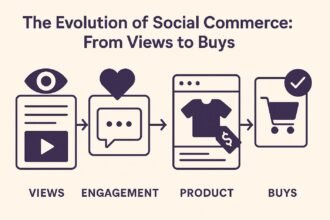Introduction to Content Marketing
Content marketing is a strategic approach focused on the creation and distribution of valuable, relevant, and consistent content to attract and retain a clearly defined audience — ultimately driving profitable customer action. It differs from traditional marketing by not promoting products or services directly; instead, it stimulates interest in the market. HubSpot defines content marketing as creating and sharing online material that does not explicitly promote a brand but is intended to stimulate interest in its products or services. Content marketing evolves like society does, supported by an increasing amount of data through the Internet’s development. Businesses understand the value of launching targeted campaigns when consumers become willing to seek precisely the information they need. Targeted content marketing allows brands to engage consumers, analyzing and learning from each contact.
What is content marketing? It is a marketing technique aimed at attracting and retaining as much interested and educated public as possible. It is not a new technique but is now experiencing a boom thanks to tools that allow precise targeting of a segment. A company sends valuable and tailored content to a target audience that needs to be educated before moving to the consideration and purchase stages. Through diversified content, a brand can attract the interest of a consumer when, by reacting, it delivers the fundamental information for the beginning of a buying process. A consumer forced to receive indiscriminate marketing will stop and even negatively take into account any promotion of the brand. Differentiated content requires in-depth knowledge of the users and the problems to be solved to intercept the curiosity of the prospect and pleasantly accompany it along the decision-making path.
Definition of Content Marketing
Content marketing is a strategy that promotes a business through sharing valuable and relevant content in order to attract a clearly defined audience and consider that audience’s ultimate goal or interest. It is commonly used across social media networks and other online platforms to attract new customers as well as provide additional information to existing customers. Content marketing is the opposite of traditional marketing, which encourages people to buy a company’s goods or services. Instead, content marketing provides those people with valuable, relevant information. When content marketing is executed effectively, it can improve a brand’s online reputation, attract new customers, and keep existing customers coming back. History shows that though the term “content marketing” was first used in 1996, the idea has been around for a very long time. In the 18th century, Benjamin Franklin published “Poor Richard’s Almanack” to attract customers to his printing business; and in 1924, Harley Davidson launched the magazine “The Enthusiast” for motorcycle riders. As companies shifted to online platforms, content marketing evolved to include a wide range of forms and channels.
History of Content Marketing
Content marketing is not a new concept. Brands have been using this type of marketing strategy since the late 19th century. Back then, the concept focused more on printing magazines and articles rather than creating online content. A good example is John Deere’s “The Furrow” magazine, launched in 1895. The magazine offered useful tips and advice to farmers and, as a result, was a great success—it is still being published today. In the early 20th century, Michelin followed with a similar tool: the “Michelin Guide,” which provided information about car maintenance, maps, and restaurant guides.
Fast forward to today, businesses are still using content marketing for similar reasons. It helps establish relationships and build trust with their target audience and potential customers. Digital marketing has evolved into one of the most powerful tools in virtually any business, and content marketing plays a key role. Brand awareness, improved customer engagement, higher conversion rates, and cost-effectiveness remain very real benefits. Moreover, content marketing enhances search engine optimization (SEO) for businesses worldwide.
Types of Content Marketing
Blog posts are a traditional and popular form of content marketing. Writing blogs atracts visitors to the business website, where conversion is more likely. Blog posts can demonstrate expertise and provide value for clients and customers. Key points include emphasizing the significance and benefits of blogging, supporting blog posts with e-books on similar topics, and explaining why blogging is an excellent choice for business content marketing.
Social media content offers a highly effective way to engage with businesses and brands. It provides a platform for businesses to showcase their brands, highlight product features, and build authority in their niche.”
Videos enable businesses to craft highly engaging and effective content. Displaying products in use, sharing client testimonials, and creating entertaining clips on related themes can enhance engagement. People often remember stories, and videos offer an excellent medium for storytelling.
Infographics present collections of information in a visually appealing and easy-to-understand manner. Information-rich content tends to go viral, reaching thousands of people swiftly. Furthermore, infographics allow businesses to engage with customers and amplify their social media presence.
Podcasts are audio programs available on platforms like Spotify and Stitcher. Businesses can provide content that piques the curiosity of their target audience, attracting new listeners and turning some into customers and clients. Podcasters can venture into new topics, interview guests, and explore other themes relevant to their business and audience.
1. Blog Posts
Blog posts remain one of the most popular formats for content marketing due to ease of production, range of applications, and the fact that it’s search engine friendly. Informative blog posts help companies gain more organic search traffic, which is excellent for brand awareness and building customer trust. In-depth guides, comparison posts, and videos can assist potential customers who are in the final stages of their buyer journey.
The HubSpot marketing agency, for example, is a master of high-quality blog writing and has dedicated over 10 years to publishing hundreds of very successful blog articles on topics such as marketing, sales, and customer relationship management.
2. Social Media Content
A variety of content is used by marketers on social media platforms. Content is posted and shared with the aim of persuading a user to pop-up with a specific intention such as sales of product, driving traffic to website or web page, brand recognition, and so on. Content marketing on social media feeds the user with information or entertainment, which can get related to the product or service. The motive is also to reach a target audience through content. Marketers post attractive and valuable content and also engage with users who are interacting, so that they can develop a relationship with the users. Marketers also interact with micro-influencers to promote their products and services where such social media influencers talks about the product by creating effective content of their own.
Content can vary according to the choice and area of the marketer. For example, an IT company will post content related to services, informative stuff such as blogs or external content which is related to the field of Information Technology. As per studies, companies are able to generate higher leads and conversions when they are posting in-depth content such as blogs and articles. Founded in August, 2007, HubSpot is an American company that produces software for inbound marketing and sales. Their key operations are providing support to businesses in areas such as customer inbound needs, product marketing, support, sales, content management, and social media among others. The company began with blog posts and keyword research and today, their website charges a domain authority of 92. The company’s insistence on testing, evaluating, and adapting restrategizing, led to them producing excellent content, which became the main source of inbound leads. Such inbound flow meant that their sales staff were spending more working leads. It later moved on to Content Marketing Management System (CMMS) and now it offers services that range from search engine optimization to social media promotions.
3. Videos
Videos make for content that is highly shareable and memorable. They increase the time users spend on a brand’s website and allow for easier understanding. Videos have potential for higher conversion as well. They’re engaging, easy to consume, and people tend to watch the entire video out of curiosity. They Utilize Multiple Feature for Engagement.
4. Infographics
Content marketing serves as a significantly more subtle form of promotion than traditional advertising. Rather than trying to explicitly sell a product or service, good content marketing provides genuinely useful or entertaining content without a direct selling pitch. One of the main reasons for producing excellent content may be that prospective customers are actively looking for it, or the content may lift brand awareness by attracting traffic to search engines or social media. A successful content marketing campaign should serve a specific business goal, such as bringing more visitors to a website, making a brand more visible, or convincing potential customers to make a purchase.
Considering The New York Times as an example, the company’s editorial content is an excellent example of great content marketing. The business gains billions of dollars from selling news to consumers, much of which is also used to attract advertisers. Providing high-quality editorial content also raises the brand awareness of The New York Times, making it a strong household name and encouraging many governments, companies, and other organizations to advertise in the newspaper.
5. Podcasts
Podcasts represent an audio form of content marketing that can be especially useful for business owners who wish to establish thought-leadership in their industry while boosting brand awareness among a deeply engaged audience. There are numerous podcast platforms to choose from, each with its own target audience. Some podcast topics are well-suited to products or services presented in an audio format because they are easy to consume while searching, driving, exercising, or doing other chores.
For example, listeners of the HubSpot-focused podcast platform, The Growth Show, have a varied range of tastes and interests but are united by their common desire to grow, innovate, and provide value to others. The show has featured different industry leaders over the years, including Matt Goldman, CEO and founder of Kabbage, as well as contributors from HubSpot. In all its episodes, The Growth Show focuses on growth—be it that of a business, career, world, or idea. By publishing a podcast with broad and diverse topics, the company has developed respectful and meaningful relationships with its listening audience.
Examples of Successful Content Marketing
Diversified; Content drives Inbound Content Marketing makes it clear that in a world of high noise and low trust, diversifying the way you communicate your brand matters. Creating an active, community-driven, brand hub provides a one-stop destination for everything related to the experience, creating multiple touchpoints for discovery and engagement that fuel continuing conversation.
Diverse approaches to content marketing: A blog that introduces any inbound strategy. HubSpot creates exceptional content that helps potential customers think deeply about their own challenges and readiness to embrace marketing automation and inbound. Calls-to-action clearly lead readers in the direction of services that may be relevant to them.
Social media content is Instagrammable. Red Bull doesn’t just promote it, it creates it. Their social media content (not to mention their ongoing events, podcasts, drama/film sponsorships, and more) make their brand the go-to team on mountain biking, air-tobogganing and other adrenaline-packed adventures that only they would dream up.
Videos make it compelling. Just watch a second of a Nike brand campaign to experience the truth of the client—“Do It.” Their videos effectively embody that sentiment. The campaigns are as memorable as the products Nike sells.
1. Case Study: HubSpot
HubSpot, an inbound marketing software company specializing in blogs, search engine optimization (SEO), social media, and more, provides an excellent example of content marketing. The company offers comprehensive free educational content through podcasts, blogs, online courses, and YouTube videos, all designed to help customers enhance their marketing game.
The genesis of HubSpot’s content marketing strategy can be traced back to the 2006 launch of its website, where the blog was central. By consistently delivering valuable educational content, HubSpot rapidly developed an audience of marketing professionals poised to purchase marketing products. Other aspects of content marketing support this objective, driving customers to the website’s vast educational content. As customers’ educational journeys advance, they are prepared for a sales funnel, moving from learning about marketing benefits to seeking software that can streamline their efforts. An inbound marketing approach that includes content marketing can effectively energize any marketing effort.
2. Case Study: Red Bull
Red Bull is an energy drink company that heavily relies on content marketing unlike typical brands. The company’s target audience consists of young people who want to feel that their lives are exciting and full of adventure. To appeal to them, Red Bull has to associate itself with the same feelings, because no one wants to act impulsively and take chances after a long night at a party with a couple of energy drinks.
To project the right image to its target audience, the company produces its own magazine, record label, radio, television stations, esports teams, and many other types of branded media. Although they still engage in traditional advertising on TV and Instagram, these endeavors are secondary to the story they’re trying to tell as a brand and a community builder.
3. Case Study: Nike
For content marketing lighting a fire, Nike appears to have struck a match. Bold, relevant, and authentic, these ads resonate with today’s consumer. Nor is it a one-hit wonder. The Nike family includes a video blog, social media, and personalized e-mailers — and the language speaks to each audience. These activities, delivered with superb consistency, have transformed Nike into a content marketing inspiration.
Using athletes’ stories to motivate, inform, and entertain, Nike explains: “Whether you want to tell the story of the people behind a product, highlight technology and performance, or shine a spotlight on the culture of sport, Nike News is one-spot-shopping for relevant, seasonal, and compelling stories on sport, inspiration, and innovation across our portfolio of brands. Come on in, look around, and get your story on.” This approach to storytelling draws new consumers to the brand, increases engagement, and builds loyalty in the process.
Benefits of Content Marketing for Businesses
Content marketing offers a wide range of benefits to businesses, including increased brand awareness and improved customer engagement. Measuring key performance indicators such as website traffic, social media engagement, and lead generation is essential for businesses to evaluate the success of their content marketing efforts and achieve their goals.
Implementing a content marketing strategy can significantly increase brand awareness by putting business information in front of potential customers in a profitable yet subtle way. Customer engagement also improves when companies provide consistent, engaging, and responsive content that helps customers find answers to their product-related questions. Content marketing typically leads to higher conversion rates compared to traditional marketing methods because tailored content more effectively appeals to specific audience segments. Moreover, content marketing is less expensive than traditional advertising and can be tracked and analyzed to optimize campaigns. Finally, content marketing enhances a website’s search engine ranking, driving more organic traffic to company pages.
1. Increased Brand Awareness
One of the primary benefits of content marketing is increased brand awareness. When businesses create high-quality, relevant content, they position themselves as industry experts. Potential customers become familiar with their name and brand, increasing the likelihood that they will buy those products. Content marketing also increases brand visibility on search engines like Google, thanks to the strategic use of keywords, seo technieken, and backlinks within the content.
Other forms of content marketing also play a significant role in raising brand awareness. Social media platforms offer companies a space to regularly publish brand-related content. This exposure helps products and services make a more lasting impression on potential customers. Similarly, investing in video marketing guarantees millions of viewers across platforms such as YouTube, Facebook, Twitter, Instagram, and Twitch. The global surge in podcast popularity allows brands to reach new audiences who prefer audio content.
2. Improved Customer Engagement
Content marketing enables businesses to develop a loyal audience and increase customer engagement. By providing valuable and relevant content, businesses engage customers and encourage interaction with their content. One of the key goals of content marketing is to nurture leads by providing relatable content to prospects alongside the services and products offered, ultimately creating customers who are more loyal and better engaged. Customer engagement involves interacting with customers at the right time, via the right channel, with appropriate content tailored to the company’s brand message.
Content marketing facilitates communication and creates meaningful and valuable conversations, encouraging customers to engage in two-way dialogue with companies. Businesses can leverage content marketing to address customer issues and offer personalized messages, thereby improving the call-to-action process, increasing sales, enhancing customer retention, and building long-term brand loyalty. Websites that focus on buyers generally have higher visitor-to-lead and lead-to-close conversion rates than those that emphasize selling.
3. Higher Conversion Rates
Apart from improving interaction with customers, content marketing influences buyers’ decision-making processes and helps convert potential customers into product users. Compelling content powers the different stages of the social media sales funnel: from awareness through lead nurturing to actual sales. Effective leads and decision-makers will find the performers that address their meeting’s objectives easier, based on the available content.
That said, conversion rates depende on well-crafted strategies and plans that precisely target the customers, timing, and contexts of needs, well designing and storing content, and powering the automated, assisted stages of the conversion funnel.
4. Cost-Effectiveness
Cost-EffectivenessCost-EffectivenessA primary advantage of content marketing over traditional marketing lies in its cost-effectiveness. While conventional methods like television ads, radio ads, and billboards can be prohibitively expensive, content creation and promotion typically require a smaller budget. Business owners interviewed for a Business.com article indicated that producing various types of content cost approximately 62% less per lead compared to traditional outbound methods. Another significant benefit of content marketing is its enduring impact; blog posts, infographics, social media content, videos, and podcasts continue to generate traffic long after their initial publication. This attribute distinguishes content marketing as a landing page that can deliver sales and brand awareness results for years, unlike short-lived traditional ad campaigns that often lack continuous visitor engagement.
Cost-EffectivenessA primary advantage of content marketing over traditional marketing lies in its cost-effectiveness. While conventional methods such as television ads, radio ads, and billboards can be prohibitively expensive, content creation and promotion generally require a smaller budget. Business owners interviewed for a Business.com article reported that producing various types of content cost approximately 62 percent less per lead than traditional outbound methods. Additionally, content’s longevity constitutes another crucial benefit: blog posts, infographics, social media content, videos, and podcasts continue to attract traffic long after their initial publication. This characteristic distinguishes content marketing as a landing page capable of delivering sales and brand awareness outcomes for years—unlike brief traditional ad campaigns that seldom maintain consistent visitor engagement over comparable periods.
5. Enhanced SEO
Despite the common misconception, SEO is not just about keywords, it’s about helping your audience find what they need. That means your main focus should be developing an effective content marketing strategy, not blindly searching for keywords. Once your content marketing strategy is developed, keywords will stem naturally from it and make your content more searchable.
Brand websites are often their potential customers’ first contact, meaning they play one of the most important roles in motivating purchasing decisions. The way a site is built is just as important as the content that’s published there, as it can affect visitors’ first impressions and significantly impact their decision to stay or leave. Moreover, such websites are the foundations of successful SEO rankings and play a supporting role in converting visitors.

Creating a Content Marketing Strategy
Content creators often overlook the fact of how travelers look for traveling ideas. Added to this, the market has become huge enough to break the boundaries. Once the method of sale is connected, everyone wants to make money out of it. Content marketing works on three factors that support the travelers in their next planning journey. The first one is selling the idea, the next thing is introducing that destination to the travellers, and the final factor is closing the trip effectively. By optimizing the three factors, the content sellers create a successful sale on the entire trip.
It seems to be the best support for the imaginative destination category. Some types of pictures and videos can help followers in their research. Using third-person content to narrate traveling experience is the new approach in content marketing. Using the third person also helps you to remain engaged with the viewers and avoid anempty ritual that appears with such destinations. For those traveling destinations, content marketing is equivalent to selling mouth watering items through the most efficient sales agents.
1. Setting Goals
Content marketing strategies should include clear, achievable, and measurable goals to help trace the success of writing efforts. Consider whether you’re trying to: – Raise brand awareness. – Establish thought leadership. – Generate direct sales. – Increase lifetime value. – Improve customer retention. – Grow website traffic. – Capture market share. – Support new products. – Expand geographically. – Gain investor interest. – Generate sales leads. – Educate about your products or services. – Improve Google rankings. – Sell more products or services. – Encourage user sign-ups. – Provide less time-consuming or more cost-effective customer support. – Increase engagement on social media platforms.
2. Identifying Target Audience
The second step in creating a content marketing strategy is identification of the target audience. It is important to understand for whom the content is intended—whether for existing customers, potential buyers, or specific people within an organization. A deep understanding of the target audience is necessary before any content is produced, as it informs the design of content that specifically addresses the needs, problems, goals, and concerns of these potential customers.
Content should be customer-centered to appeal specifically to a particular group with distinct requirements. Customers’ preferences for content format should also be considered; some may favor blog posts or articles, while others might find instructional or product-release videos more informative. Tailoring content format to the preferences of the target audience enhances relevance and engagement.
3. Content Planning
After establishing the marketing objectives and determining the target audience, the next step in a content marketing strategy is identifying the appropriate content types. The variety of content formats available makes the content type selection a critical component of ensuring the success of the content marketing plan.
Examples of common content types include blog posts, social media posts, videos, infographics, and podcasts. Following the selection of content types, attention must also be paid to content distribution channels. The following sections present examples of specific combinations of content types and distribution modes.
4. Content Distribution
Once marketers have produced content they feel confident sharing with the world, the next step is distributing it. The goal of any good content marketing strategy is attracting and retaining an audience, and acting as a thought leader for both existing and potential customers. Without an effective content distribution strategy a brand risks falling behind competitors, and losing the attention of its target audience.
Social media content distribution is a relatively inexpensive and simple option — a way for brands to reach billions of potential customers. However, it also requires regular use and may incur budget costs to enable the algorithm to display it to a wider audience. Alternatives include community building, partnerships or influencer marketing, paid advertising, and organic search. Therefore, a comprehensive content marketing plan considers how each channel can push content to an awaiting audience.
Measuring the Success of Content Marketing
Content marketing has rapidly evolved into an effective strategy for creating brand awareness and gaining customer loyalty. Marketing challenges have thus shifted towards maintaining consistency, adapting to changing trends, content saturation, and measuring the success of content marketing campaigns. Measuring the success of a content marketing campaign is often challenging. Content marketing is a strategy that relies on the creation and distribution of interesting and relevant content to attract and acquire a target audience that can ultimately be converted into customers. Determining the effectiveness of content against set goals helps in understanding what works and what does not.
Factors such as reach, impressions, social shares, engagement and conversation on content through clicks, comments, video views, website visitation and downloads can be analysed. Brands often find it difficult to identify Key Performance Indicators (KPIs) that best measure content marketing success. Tracking KPIs is essential so marketers know if they are on the path to meeting their goals. The ideal KPIs and the tools needed to measure them differ according to the goal set and the type of content. Google Analytics pixels embedded in the content can identify details about the performance of the content.
1. Key Performance Indicators (KPIs)
Developing a content marketing strategy rests on the ability to measure its KPIs. Tracking a strategy’s effectiveness can be achieved by measuring the website, blog, social media, and sales funnel results, and by using the right tools that support the measurement process.
The more targeted and valuable the content is, the more it stimulates conversations with customers, builds the audience, encourages referrals, and converts prospects into customers. Content marketing strategies usually play an important role in a company’s overall marketing plan because they contribute to brand building, likeability, reputation, and SEO (search engine optimisation) rating. Most strategies focus on content creation, distribution, publication, and evaluation, operating on certain goals for the creation and promotion of content for the brand’s target market. Every strategy needs clearly defined goals and a targeted audience, which determines the kind of content to be created, the right message channels, and the possible referrals generated.
2. Tools for Measurement
The remarkable growth of content marketing strongly underlines the need for companies to analyse the development of their activities in this field and to understand how their users react to planned publishing campaigns. New tools have recently appeared on the market, enabling analysts to introduce new key performance indicators with the aim of analysing the new dimension of marketing in social networks.
Content marketing is based on the creation of appropriate posts that engage a group of users in discussions. Classical keywords, such as engagement rate, sector affinity or brand affinity, have been replaced by new ones—audience growth rate, customer care rate, response rate and collections associated with the themes of the user’s interest. The development of new indicators connected with content marketing stems from the fact that it is difficult to utilise long textual descriptions to identify a user’s desire to participate in a conversation. The classification of users, who write posts, in order to find the audience necessary to continue the discussion, made it possible for analysts to determine that the effectiveness of content marketing actions can be measured.
Challenges in Content Marketing
Content marketing can be expensive, especially for those companies that don’t have the expertise, tools, or manpower internally to execute their strategies. Many business executives struggle to justify the ongoing cost, despite the proven benefits. While content marketing provides compounding benefits that increase over time (such as growing website traffic and search engine visibility), it can be difficult to convince leaders accustomed to more traditional forms of marketing, which typically deliver targeted results over a short period. In terms of these long-term gains, content marketing succeeds where the others fail.
As discussed, a successful strategy requires consistency, relevance, and originality—expectations that can be hard to maintain in competitive markets. The dilemma that many marketers face as the industry continues to evolve is: “If everyone is doing it, how can my brand be different?” Furthermore, content marketing is an ever-changing landscape, and marketers need to navigate the shifting priorities of consumers and search engines to stay ahead of the pack.
1. Content Saturation
As more companies use content marketing to advertise their products and services, it becomes difficult for your content to stand out. To reduce the impact, focus on quality rather than quantity, and try to look for unique and innovative methods of connecting with consumers. Maintaining Consistency Many people believe content marketing is an easy method because it is based on communication, but brand managers know that it can take a great deal of time, skill, and effort to deliver successful content marketing campaigns. Brands that struggle with consistency will find it increasingly difficult to engage their audiences. Adapting to Trends It is important to continuously learn about and apply new content marketing methods because users’ preferences change over time; they expect content marketing to reflect current trends, so adherence to tradition will quickly cause you to lose your audience.
Artificial intelligence (AI) encompasses a broad concept of machines mimicking human intelligence, including the ability to learn and solve problems. Marketing is the science of selling products or services. In this context, AI in marketing refers to tools and systems capable of extracting insights from information hidden within large marketing data systems to improve decision-making regarding product development and campaign management. AI can play a crucial role in content marketing by making activities more efficient and useful. According to recent articles, AI can significantly assist marketers in creating relevant, personalized, and timely content that genuinely benefits customers. For this reason, companies are integrating AI features into their content marketing platforms to capitalize on this growing trend.
2. Maintaining Consistency
With more businesses adopting content marketing, it’s also become more difficult to maintain the consistency it requires. Audiences are being served more personalized content than ever before. If a brand suddenly becomes inconsistent with its content or approach, customers will notice—and they get frustrated.
Imagine you follow a brand on Instagram, attracted by their witty memes and relatable comments on pop culture. Then one day, they totally change their tone and become serious and formal, while still sharing memes. You would be confused because it isn’t what you signed up for. In terms of brand voice, it’s inconsistent and hurts the overall user experience. Maintaining consistency means keeping the same tone of voice and style and being active on each channel your audience uses.
3. Adapting to Trends
Content marketing, where brands offer products-on-tap instead of merely want-advertising, is inherently flexible. Change is built in, from the pursuit of novelty and relevance in the social manager’s daily battle to devise content that will capture public-interest buzz, to the desire for a brand identity that keeps pace with an ever-shifting cultural context. But keeping a constant flow of original and engaging content is, in practice, notably difficult, and especially draining on resource; and brand-followers’ responses can be awkward, with potentially serious unbalancing effects.
The flexibility of content marketing means that trends such as content saturation, and the growing dissonance between the careful balance of a brand’s story and the warm, familiar, fuzzy feeling invoked by nostalgia, can be avoided altogether: by simply deciding to stop producing content. So far, though, withdrawal has been an infrequent option. Brands continue to produce content—and, at the level of cultural commentary, the constant inflow likewise remains a fixed and charged element in the public’s ambient experience of the web.
Future Trends in Content Marketing
Content marketing continues to accelerate at a remarkable pace, with digital strategies gaining emphasis. Budgets for digital marketing are increasing, while traditional marketing expenditures decline. Almost every area of business benefits from content marketing, with advertising, customer experience, public relations, and digital marketing experiencing the most rapid growth. Advanced content strategies are identified as the number one opportunity for monetization in the digital region.
The future of content marketing will be shaped by the growing use of artificial intelligence and automation, the quest to deliver a personalized experience at scale, and the explosion in video content. Artificial intelligence streamlines the entire marketing process, guiding content strategy and planning, enhancing target audience communication, and analyzing results. Automation empowers marketers to focus on strategy, specialization, and expertise.
These and other advanced content marketing strategies are transforming the industry. In light of the benefits, businesses of all sizes should consider adjusting their approach to content marketing to remain relevant and effective in the digital age.
1. AI and Automation
With the increasing amount of available data—and the desire to glean substantial insights from all of it—more marketers are turning to artificial intelligence (AI) and machine learning tools. Adopting automation more frequently streamlines sales and marketing tasks and teams, resulting in more efficient workflows. For instance, Intentions.AI creates content ideas automatically, while GrowthBar leverages AI to perform keyword research, competitor analysis, and outline generation.
ChatGPT has also gathered massive attention. Marketers can use the tool to perform diverse functions: responding to inbound sales and marketing inquiries, brainstorming campaign ideas, composing emails and social posts, creating outlines for long-form blog posts, and more. This will undoubtedly have a major impact on the marketing landscape.
2. Personalization
Personalization has become a driving force in content marketing. Marketers can use data collection and analysis to obtain detailed information about their target audiences. Then, companies generate buyer personas to fully understand customers’ online behavior and preferences. For instance, consumer insights such as location, demographics, interests, favorite online platforms, purchasing behavior, and unique needs can be derived from social media analytics, web analytics, and the client management section in Digital Marketing Management Systems (DMMS).
After formulating buyer personas, marketing specialists begin planning tailored marketing content. The logic behind these planning steps is simple: why spend time and money on creating and promoting a piece of content that is unlikely to resonate with users? Marketing messages must be relevant and personalized to satisfy the social and emotional needs of the target audiences.
3. Video Content Dominance
Video content on social media channels, including TikTok and Instagram Reels, consistently achieves the greatest reach and engagement. Unsurprisingly, video advertising outperforms other formats by a large margin, reinforcing the enduring value of visual media. However, emerging formats succeed not solely because they are video, but because they align with the specific of audiences on these platforms.
Other trends are expanding the scope and ambition of content marketing. As artificial intelligence and automation mature, personalization is becoming core to low-cost, high-impact content experiences. Meanwhile, the dominance of short-form video may be challenged by a renewed appetite for deeper, more immersive content.
Final Insights and Essential Highlights on Content Marketing Strategies
Content marketing is a marketing approach focused on creating and distributing valuable and relevant content to attract and retain clearly defined audiences. Unlike traditional advertising that explicitly promotes a brand’s products or services, content marketing aims at providing valuable information that people want or need. This naturally attracts potential customers, thereby increasing brand awareness and sales. It encompasses different content types, including blog posts, social media posts, videos, infographics, eBooks, podcasts, and email newsletters.
Content marketing has been practiced since the 19th century, but it has enjoyed special popularity in recent years as a result of developments in information technology. The aim of content marketing is not just to inform; rather, it is to provide the answer to people’s questions or problems at the right place and time during the purchase process, and to convince them that the related product or brand is the best alternative. Nurturing people and potential customers through targeting is completed with content marketing.












